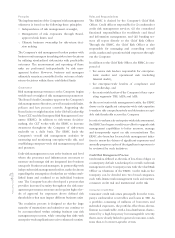American Express 2004 Annual Report Download - page 45
Download and view the complete annual report
Please find page 45 of the 2004 American Express annual report below. You can navigate through the pages in the report by either clicking on the pages listed below, or by using the keyword search tool below to find specific information within the annual report.
Consumer credit risk is managed within a highly orga-
nized structure of Board-approved policies covering all
facets of credit extension, including approvals, autho-
rizations, line management and fraud prevention. The
policies ensure consistent application of credit man-
agement principles and standardized reporting of asset
quality and loss recognition metrics across domestic
and international portfolios. Moreover, consumer
credit risk management is supported by sophisticated
proprietary scoring and decision-making models.
Credit underwriting decisions are made based on a
sophisticated evaluation of product economics and cus-
tomer behavior predictions. The Company has devel-
oped unique decision logic for each customer interac-
tion, including prospect targeting, new accounts, line
assignment, line management, balance transfer, cross
sell and account management. Each decision has ben-
efited from sophisticated modeling capability that uses
the most up-to-date information on customers, includ-
ing extensive payment history, purchase data and
insights from proprietary data feeds from all three credit
bureaus.
In addition to the impact of improved risk management
processes, the Company’s overall consumer credit per-
formance has also benefited from the shifting mix of
the portfolio towards products that reward the cus-
tomer for spending. Rewards attract higher spending
from premium customers, which in turn leads to lower
credit loss rates. Moreover, rewards and other incen-
tives offered at acquisition improve the risk profile of
new customers. Since 2001, the percentage of accounts
receivable from rewards-based products has increased
from approximately 45 percent to 70 percent.
The combination of reward-related spending growth
and improved risk management processes has resulted
in lower credit losses for every vintage. For example,
the loss rate of the 2004 vintage is 40 percent lower than
that of the 2003 vintage. Similarly, the Company is
experiencing lower credit losses for every tenure, with
a 19 percent improvement since 2001 from accounts
with a tenure greater than 5 years and a 12 percent
improvement from accounts with a tenure less than 5
years.
The asset quality of the consumer portfolio is discussed
in the TRS Results of Operations section.
Institutional Credit Risk
Institutional credit risk arises in each of the Company’s
operating segments:
©insurance and investment certificates at AEFA;
©the corporate card, large establishment services and
network services businesses within TRS; and
©the Financial Institutions Group at AEB.
Unlike consumer credit risk, institutional credit risk is
characterized by a lower loss frequency but higher
severity that, although affected by general economic
conditions, is generally linked to more borrower-
specific events. The Company’s senior risk officers rec-
ognize that the absence of large losses in any given year
or over several years is not representative of the riski-
ness of an institutional portfolio, given the infrequency
of loss events in such a portfolio.
In 2004, the ERMC initiated a major project to upgrade
risk management practices relating to institutional
credit risk exposures. A key goal of this initiative is to
establish escalation procedures for scrutinizing institu-
tional exposures based on the size or riskiness of
proposed exposures. These institutional credit man-
agement processes will be formalized in credit policies
to be reviewed and approved by the Company’s Board
on an ongoing basis.
Market Risk Management Process
Market risk represents the loss in value of portfolios and
financial instruments due to adverse changes in market
variables. The Company’s market risk consists of:
©interest rate risk in its card, insurance and certificate
businesses;
©foreign exchange risk in its international operations;
and
©equity market risk in asset management.
Market risk is centrally managed by the corporate trea-
surer who also acts as the Vice Chairman of the ERMC.
Within each business, market risk exposures are moni-
tored and managed by various asset liability commit-
tees within the parameters of Board-approved policies
covering derivative financial instruments, funding and
investments. With respect to derivative financial instru-
ments, the value of such instruments is derived from an
underlying variable or multiple variables, including
commodity, equity, foreign exchange and interest rate
indices or prices. These instruments enable the end
users to increase, reduce or alter exposure to various
market risks and, as such, are an integral component
of the Company’s market risk and related asset liability
management strategy and processes. Use of derivative
financial instruments in each line of business risk man-
agement process is incorporated into the discussion
below as well as the respective segment risk manage-
ment section.
AXP
AR.04
43
Financial Review
























